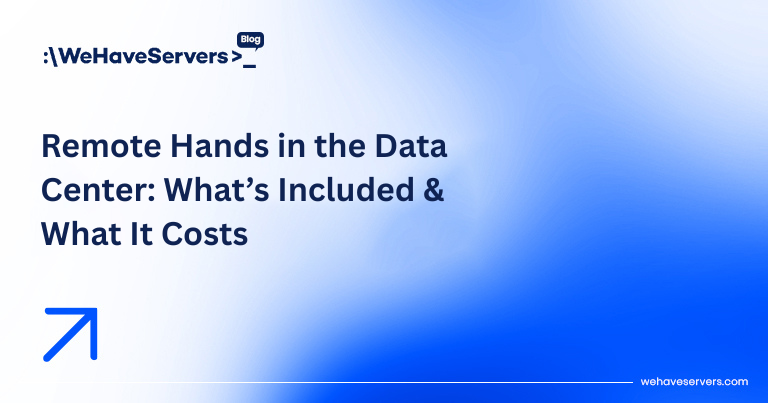
Remote Hands in the Data Center: What’s Included & What It Costs
Remote Hands in the Data Center: What’s Included & What It Costs
One of the biggest advantages of colocation hosting is that your servers live inside a professional facility with 24/7 staff. But since most clients can’t be physically present in the data center, providers offer a service called remote hands. This means trained technicians on-site can perform tasks on your behalf — from rebooting a hung server to replacing failed hardware. In 2025, as more businesses move workloads into colocation, understanding what remote hands includes and how much it costs is crucial for planning your infrastructure operations.
🔹 What Are Remote Hands Services?
Remote hands refers to technical support performed by data center staff at the customer’s request. Unlike “smart hands” (higher-level engineering tasks), remote hands usually cover physical tasks such as:
- Power cycling a server (hard reboot).
- Pressing buttons, checking status LEDs, reseating cables.
- Replacing failed drives, memory modules, or power supplies.
- Swapping tapes, inserting/removing USB drives or ISOs via KVM.
- Labeling, inventory, or taking photos for documentation.
- Rack-and-stack (mounting new servers and switches).
- Connecting/disconnecting cross-connects or patch cables.
In short: if you need something done physically in the rack, remote hands technicians are your proxy.
🔹 Why Remote Hands Matter
- 24/7 Availability: Colocation facilities operate around the clock. You don’t need to send your own staff at 3 AM for a drive replacement.
- Faster Recovery: A failed power supply or crashed OS can be handled in minutes, not hours.
- Global Operations: Companies colocating in multiple regions rely on remote hands instead of traveling onsite.
- Cost Efficiency: Avoids maintaining your own staff presence inside the data center.
🔹 What’s Typically Included
Remote hands packages vary, but most data centers offer a common baseline:
Standard Services
- Power reboots.
- Checking and reseating network/power cables.
- Monitoring indicator lights and reporting status.
- Basic hardware replacements (customer-supplied spare parts).
Extended Services (“Smart Hands”)
- Complex installations (rack design, structured cabling).
- OS installation via KVM-over-IP or local media.
- Configuration of switches/routers (at customer direction).
- Assisting during migration projects or audits.
🔹 Remote Hands Cost Models
Pricing depends on location, SLA level, and scope of services. In Eastern Europe (including Romania), prices are significantly lower than Western Europe or the US.
- Per Ticket / Per Task: €25–€50 per incident (simple reboot).
- Hourly Billing: €50–€150/hour, billed in 30-minute increments.
- Monthly Bundles: €200–€500/month for a block of hours (5–10 hours).
- Premium SLA: Priority response within 15 minutes — usually 1.5× standard hourly rate.
At WeHaveServers.com, for example, a basic reboot task might cost €30, while a full rack installation project could run €300–€500 depending on complexity.
🔹 SLA & Response Times
Remote hands effectiveness depends on the SLA agreed with the provider:
- Standard SLA: Response within 1–2 hours.
- Premium SLA: Response within 15–30 minutes.
- Custom SLA: Dedicated on-call technicians for enterprise clients.
For mission-critical workloads (banks, trading platforms, SaaS providers), premium SLAs are worth the additional cost.
🔹 Limitations of Remote Hands
Not everything can be done remotely. Common restrictions include:
- No vendor troubleshooting beyond physical tasks (software config is usually customer responsibility).
- No root-level access to systems unless explicitly authorized.
- Specialized tasks (e.g., storage array firmware upgrades) may require certified engineers.
Always clarify the scope of responsibility in your colocation contract.
🔹 Best Practices for Using Remote Hands
- Be Precise: Provide clear instructions (e.g., “replace disk in slot 3 with labeled spare”).
- Use Diagrams: Label servers and cables ahead of time.
- Maintain Spares: Store replacement hardware onsite in your rack or colo’s spare parts storage.
- Leverage Monitoring: Use Zabbix, Prometheus, or IPMI/iDRAC alerts to trigger remote hands tickets.
🔹 Real-World Examples
Case 1: SaaS Provider with 24/7 Clients
- A drive failed in the middle of the night.
- Remote hands replaced it within 20 minutes using pre-staged spares.
- No SLA violation occurred.
Case 2: Global Enterprise with Multi-Region Colocation
- Servers in Bucharest, Frankfurt, and New York.
- Remote hands contracts allowed operations without flying in staff.
✅ Conclusion
Remote hands services are the unsung hero of colocation. They provide the physical presence your infrastructure needs, without requiring you to be onsite. In 2025, leveraging remote hands with clear instructions, spare parts, and SLA-backed contracts is the most effective way to keep colocated infrastructure reliable, resilient, and cost-efficient.
At WeHaveServers.com, all colocation clients benefit from 24/7 remote hands availability in our Tier III Romanian/EU facilities, ensuring rapid response to hardware incidents, migrations, or client-specific tasks.
❓ FAQ
What’s the difference between remote hands and smart hands?
Remote hands = physical/basic tasks (reboots, cable checks). Smart hands = advanced technical work (config, troubleshooting).
How much does remote hands cost?
Typically €50–€150/hour, with simple tasks like reboots billed at €25–€50 each.
Can I store spare parts in the data center?
Yes. Most colocation providers allow you to keep spares in your rack or secure storage for quick replacement.
Do providers guarantee response times?
Yes, via SLA. Premium contracts guarantee <15-minute responses for critical workloads.
Are remote hands available 24/7?
Yes, in all Tier III+ colocation facilities. Availability is one of the main reasons businesses use colocation.



